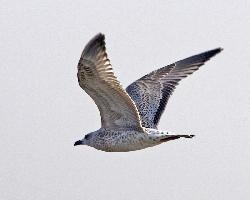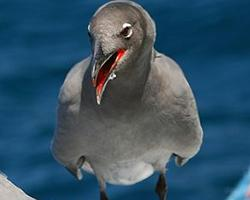
Váhy a míry
| Délka | od 40 do 56 cm |
|---|---|
| Hmotnost | od 300 do 600 g |
| Délka rozpětí křídel | od 110 do 120 cm |
Stav ohrožení
| Ohrožen |
Popis zvířete
The Common Gull, scientifically known as Larus canus, is a medium-sized bird that is part of the Laridae family, which includes gulls, terns, and skimmers. This species is widespread across Eurasia, with some populations migrating to coastal areas in Western Europe and the British Isles during the winter. The Common Gull is a versatile and adaptable bird, often found in a variety of habitats ranging from coastal regions, estuaries, and beaches to inland areas such as fields, lakes, and rivers.Adult Common Gulls are characterized by their sleek, streamlined bodies that measure approximately 40-46 cm in length, with a wingspan ranging from 110 to 125 cm. They possess a relatively light build compared to other gulls, with a rounded head and a slender, pointed bill that is typically yellow with a greenish or blackish tint near the tip. The plumage of the adult Common Gull during the breeding season is predominantly white, with a light grey back and upper wings. The wingtips are black with distinctive white 'mirrors' on the outermost primary feathers, which are visible in flight. The legs are usually greenish-yellow, contributing to their distinctive appearance.
One of the most striking features of the Common Gull is its eyes, which are bright yellow with a red or black orbital ring, giving it a keen, alert expression. In the non-breeding season, the adult's head may exhibit grey streaking, which distinguishes it from its breeding plumage.
Juvenile Common Gulls display a mottled brown and white plumage, which gradually transitions to the adult coloration over the course of three to four years. This gradual maturation process allows for the observation of various plumage stages within a population.
Common Gulls are omnivorous, feeding on a wide range of food items, including fish, insects, worms, small rodents, and scraps from human activity. They are opportunistic feeders, often seen foraging in fields behind ploughs or picking edible material from garbage dumps. Their feeding behavior showcases their adaptability and ability to exploit different food sources depending on availability.
The breeding season of the Common Gull typically begins in April or May, when pairs establish territories and construct nests on the ground. The nest is a simple structure, often lined with grass, feathers, and other soft materials. The female usually lays two to three eggs, which are incubated by both parents for about three to four weeks. The chicks are precocial, meaning they are relatively mature and mobile from the moment of hatching. Both parents are involved in feeding and protecting the chicks until they fledge at around five to six weeks of age.
In terms of vocalization, Common Gulls are less noisy compared to other gull species. Their calls include a variety of sounds, from a soft "mew" reminiscent of a cat, to harsher alarm calls when threatened.
The Common Gull, while not currently listed as endangered, faces threats from habitat loss, pollution, and changes in food availability due to human activity. Conservation efforts aimed at preserving their natural habitats and ensuring sustainable food sources are crucial for the long-term survival of this adaptable and fascinating species.
Podobná zvířata
Nové fotografie zvířat
Top 10 zvířat
- Common cockchafer (Melolontha melolontha)
- Common house mosquito (Culex pipiens)
- Colossal squid (Mesonychoteuthis hamiltoni)
- Hooded merganser (Lophodytes cucullatus)
- Fruit fly (Drosophila melanogaster)
- Australian box jelly (Chironex fleckeri)
- Elephant hawk moth (Deilephila elpenor)
- Common reed warbler (Acrocephalus scirpaceus)
- Moustached guenon (Cercopithecus cephus)
- Diana monkey (Cercopithecus diana)


